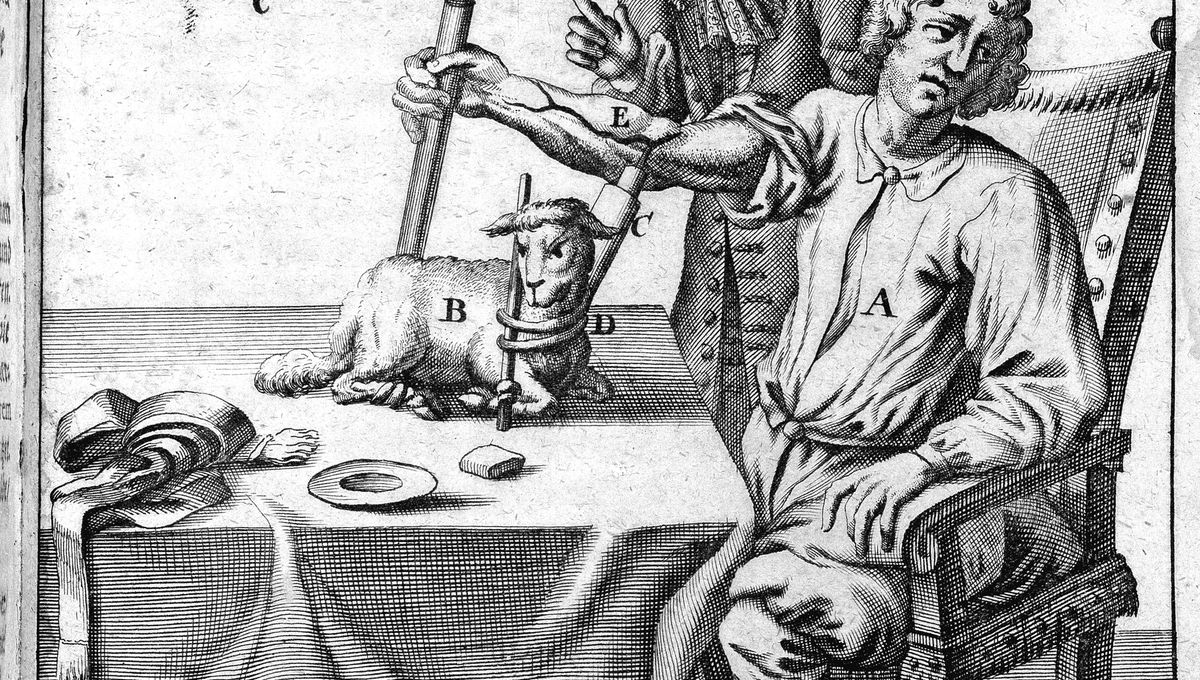
We wouldn’t normally expect milk to be used in many medical procedures today, least of all in blood transfusions – but for a brief period of history, this substance was actually transfused instead of blood.
For as long as humans have been injuring themselves, there has been a need for blood replacements. According to some, Spanish Conquistadors allegedly witnessed the Incas of Peru performing blood transfusions while they explored the “New World”. If this is true, though the evidence is thin, it would be the earliest example of a procedure of this type in the historical record. Nevertheless, once William Harvey described the circulation of blood in 1616, European experiments – some more bizarre than others – became common.
In 1666, at the Royal Society in London, Richard Lower, a physician and surgeon, transfused blood between two dogs using a goose quill to connect an artery from one to the jugular vein of the other. In 1667, Jean-Baptiste Denys, a French physician, performed the first fully documented animal-to-human blood transfusion.
The patient was a teenage boy who had undergone twenty blood lettings as a treatment for fever. According to Hippocratic medicine, the dominant medical tradition at the time, this was a standard procedure for removing perceived impurities from the body, but the treatment had left the boy understandably weak. Denys transfused blood from the carotid artery of a lamb into the boy’s veins. The boy survived and his condition improved, the lamb did not.
The hope for blood transfusions was that they would not only improve health and remove disease, but could even change the recipients’ personalities and remove madness. However, in most cases, the procedure only led to death which eventually resulted in the Châtelet edict in 1668 which prohibited blood transfusions and more or less saw the procedure fall into oblivion for nearly a century and a half.
The procedure had a brief revival in the early nineteenth century when the obstetrician, James Blundell, performed a transfusion with a syringe containing defibrinated blood (blood without fibrin, which helps it clot) to prevent coagulation. Although this was an improvement on earlier attempts, the process still did not catch on as preventing coagulation and the patient’s tendency to die made it an unappealing procedure. Then, in the mid-nineteenth century, scientists came up with a new idea – why transfuse blood when you can transfuse something else? Why not milk?
In 1854, Drs James Bovell and Edwin Hodder injected milk into humans during the cholera epidemic in Toronto, Canada. They had been inspired by the work of Denys who, in addition to transfusing lambs’ blood into his patients, had also injected milk into various animals where he believed “the minute oil and fatty particles found in milk” would be turned into “white corpuscles of the blood”. Bovell and Hodder believed the milk helped regenerate white blood cells and, surprisingly, their first patient given a milk transfusion actually survived and improved in health (the next five patients regrettably died).
It was soon assumed that this treatment was a safe and legitimate replacement for blood. Milk transfusions become a popular method of treatment, especially in North America. However, many medical practitioners remained skeptical, and the large number of deaths among patients receiving it as a treatment soon led to it being thoroughly discredited. By the 1880s, saline infusions had replaced milk as a substitute for blood. Then, at the turn of the century, a safe and effective way to transfuse blood was established after Karl Landsteiner discovery of the first three human blood types.
Today, blood transfusions are a well-practiced and standardized medical procedure today, with around 4.5 million people in America and approximately 2.5 million units of blood transfused in the UK each year. The demand for blood is so high that over 118.5 million blood donations have been collected across the world, according to the World Health Organization.
Transfusions save lives and are often given to people who have suffered severe blood loss through injury, surgical procedures, or childbirth. They are also used in a range of treatments for conditions such as hemophilia, kidney failure, and even cancer.
Source Link: Nineteenth-Century Doctors Used Milk For Blood Transfusions